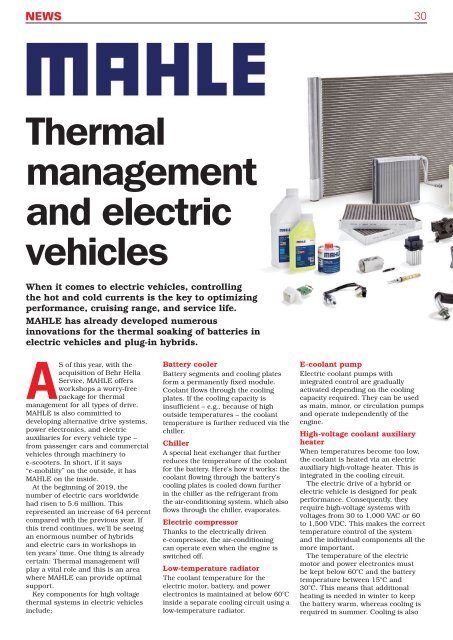The Garage 318
Create successful ePaper yourself
Turn your PDF publications into a flip-book with our unique Google optimized e-Paper software.
NEWS 30<br />
<strong>The</strong>rmal<br />
management<br />
and electric<br />
vehicles<br />
When it comes to electric vehicles, controlling<br />
the hot and cold currents is the key to optimizing<br />
performance, cruising range, and service life.<br />
MAHLE has already developed numerous<br />
innovations for the thermal soaking of batteries in<br />
electric vehicles and plug-in hybrids.<br />
AS of this year, with the<br />
acquisition of Behr Hella<br />
Service, MAHLE offers<br />
workshops a worry-free<br />
package for thermal<br />
management for all types of drive.<br />
MAHLE is also committed to<br />
developing alternative drive systems,<br />
power electronics, and electric<br />
auxiliaries for every vehicle type –<br />
from passenger cars and commercial<br />
vehicles through machinery to<br />
e-scooters. In short, if it says<br />
“e-mobility” on the outside, it has<br />
MAHLE on the inside.<br />
At the beginning of 2019, the<br />
number of electric cars worldwide<br />
had risen to 5.6 million. This<br />
represented an increase of 64 percent<br />
compared with the previous year. If<br />
this trend continues, we’ll be seeing<br />
an enormous number of hybrids<br />
and electric cars in workshops in<br />
ten years’ time. One thing is already<br />
certain: <strong>The</strong>rmal management will<br />
play a vital role and this is an area<br />
where MAHLE can provide optimal<br />
support.<br />
Key components for high voltage<br />
thermal systems in electric vehicles<br />
include:<br />
Battery cooler<br />
Battery segments and cooling plates<br />
form a permanently fixed module.<br />
Coolant flows through the cooling<br />
plates. If the cooling capacity is<br />
insufficient – e.g., because of high<br />
outside temperatures – the coolant<br />
temperature is further reduced via the<br />
chiller.<br />
Chiller<br />
A special heat exchanger that further<br />
reduces the temperature of the coolant<br />
for the battery. Here’s how it works: the<br />
coolant flowing through the battery’s<br />
cooling plates is cooled down further<br />
in the chiller as the refrigerant from<br />
the air-conditioning system, which also<br />
flows through the chiller, evaporates.<br />
Electric compressor<br />
Thanks to the electrically driven<br />
e-compressor, the air-conditioning<br />
can operate even when the engine is<br />
switched off.<br />
Low-temperature radiator<br />
<strong>The</strong> coolant temperature for the<br />
electric motor, battery, and power<br />
electronics is maintained at below 60°C<br />
inside a separate cooling circuit using a<br />
low-temperature radiator.<br />
E-coolant pump<br />
Electric coolant pumps with<br />
integrated control are gradually<br />
activated depending on the cooling<br />
capacity required. <strong>The</strong>y can be used<br />
as main, minor, or circulation pumps<br />
and operate independently of the<br />
engine.<br />
High-voltage coolant auxiliary<br />
heater<br />
When temperatures become too low,<br />
the coolant is heated via an electric<br />
auxiliary high-voltage heater. This is<br />
integrated in the cooling circuit.<br />
<strong>The</strong> electric drive of a hybrid or<br />
electric vehicle is designed for peak<br />
performance. Consequently, they<br />
require high-voltage systems with<br />
voltages from 30 to 1,000 VAC or 60<br />
to 1,500 VDC. This makes the correct<br />
temperature control of the system<br />
and the individual components all the<br />
more important.<br />
<strong>The</strong> temperature of the electric<br />
motor and power electronics must<br />
be kept below 60°C and the battery<br />
temperature between 15°C and<br />
30°C. This means that additional<br />
heating is needed in winter to keep<br />
the battery warm, whereas cooling is<br />
required in summer. Cooling is also


















